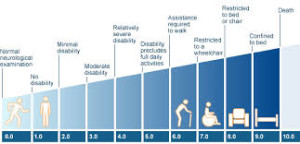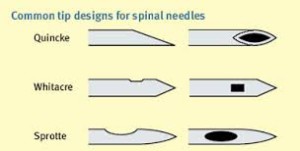48 weeks, half way there
I have been on the ASCEND trial for 48 weeks, half way through, so that’s another 12 more infusions.

Halfway there, 48th week
Could Biogen Idec have a treatment for secondary progressive multiple sclerosis (SPMS)?
I have spent the last two days up at the Royal London hospital having tests.Yesterday (Monday) was taken up with assessing my EDSS (Expanded Disability Status Scale) score. I think that I’m still somewhere between 6.0 & 6.5. My balance has deteriorated, and my walking is more deliberate. Today (Tuesday) was a lumbar puncture.
Expanded Disability Status Scale
The Expanded Disability Status Scale (EDSS) is a method of measuring disability in multiple sclerosis. It is used to monitor changes in the level of disability and or impairment over time. It is widely used in clinical trials and in the assessment of people with MS. Some people would argue that EDSS is both expensive, and it is flawed. EDSS only measures mobility, but MS affects so many other parts of the body. For example, it does not take into account the severity of damage to one’s mental state or optical ability or bladder functionality.
Other problems with the EDSS

EDSS used to measure progress of MS
An EDSS assessment requires a neurological examination. It is a detailed assessment of the patient, and it lasts anywhere between 20 to 40 minutes. This makes it both expensive and not feasible in a general MS clinic where each appointment might only last 15 minutes. At the moment, there is no other universally recognized measurement of MS progression.
I know someone who has optic neuritis and has only a small amount of periphery vision out of each eye. Imagine having a cardboard ring on your glasses. there is just a large grey area when you look directly at your face in the mirror, all you an see are the edges. I know she has some bowel and bladder problems but nothing else. Her walking is fine. So her EDSS score would be about 4 compared to mine which is about 6.0 to 6.5. I would not like to say which of us is more disabled by MS.
Though it is flawed, EDSS is the recognized way of measuing progression of MS.
Lumbar puncture

Lumbar puncture needles
A thin needle is inserted into the spinal canal, this is the channel running down the spine that contains the spinal cord. The pressure within the spinal canal is usually measured, after which some of the cerebrospinal fluid is removed. The fluid is drained drop by drop and, it takes about 45 minutes to get a big enough sample to be sent for testing. Afterwards, you must lie flat on your back for an hour and drink as much liquid as possible.
In most cases, the lumbar puncture (LP) is carried out while you are lying on your side, with your legs pulled up and your chin tucked in. A hollow needle is inserted into the base of the spine, under local anaesthetic. I had an LP when I first started the ASCEND trial; it was a really unpleasant experience. The first doctor could not insert the needle correctly and I could feel the tension and concern so a more experienced one had to do the deed. I was really dreading this one, but there was no pain or discomfort.
Why a lumbar puncture
In the spinal fluid there are proteins, one class is neurofilaments. If the level of them rises then this is indicative of more damage to the nerves and thus a worsening of the MS. Effective disease-modifying and neuroprotective therapies should reduce or even stop the increase of neurofilament levels in the spinal fluid. This is a simplification so mere mortals like you and I can understand the purpose of an LP.
Looking on the bright side this process should enable researchers to identify the success or failure of a potential treatment in a lot less time than currently required. If this process is adopted it will make MS trials last only a few months rather than a couple of years so they become much cheaper. They will also be much less subjective and more objective ,
Am I any better?
There we have it, 48 weeks on the ASCEND trial. Since it started my balance has got worse, I do walk more slowly, and my double vision happens more frequently. The progress of my MS is still very slow but is it even slower, ‘I don’t know’ is the answer?



Leave a Reply